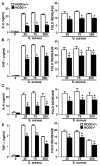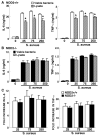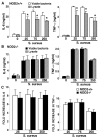NOD2 contributes to the inflammatory responses of primary murine microglia and astrocytes to Staphylococcus aureus
- PMID: 20226841
- PMCID: PMC2859426
- DOI: 10.1016/j.neulet.2010.03.013
NOD2 contributes to the inflammatory responses of primary murine microglia and astrocytes to Staphylococcus aureus
Abstract
We have recently demonstrated that microglia and astrocytes express nucleotide-binding oligomerization domain-2 (NOD2), a novel cytosolic pattern recognition receptor for bacterial motifs, and we have shown that this intracellular receptor is essential for glial responses to Gram-negative pathogens. Here, we demonstrate that intact Staphylococcus aureus, a major Gram-positive causative agent of brain abscesses, activates the transcription factor NF-kappaB and is a potent stimulus for inflammatory cytokine production in primary murine microglia and astrocytes. Interestingly, we demonstrate that NOD2 is essential for maximal glial responses to intact S. aureus, but not cellular lysates. As such, this data indicates that NOD2 plays an important role in initiating inflammatory mediator production by resident brain cells following S. aureus infection and we suggest that this cytosolic receptor acts in conjunction with cell surface pattern recognition receptors to elicit maximal glial responses.
Copyright 2010 Elsevier Ireland Ltd. All rights reserved.
Figures




Similar articles
-
NOD2 plays an important role in the inflammatory responses of microglia and astrocytes to bacterial CNS pathogens.Glia. 2009 Mar;57(4):414-23. doi: 10.1002/glia.20770. Glia. 2009. PMID: 18803303 Free PMC article.
-
NOD2 mediates inflammatory responses of primary murine glia to Streptococcus pneumoniae.Glia. 2010 May;58(7):839-47. doi: 10.1002/glia.20968. Glia. 2010. PMID: 20091781 Free PMC article.
-
Functional expression of NOD2, a novel pattern recognition receptor for bacterial motifs, in primary murine astrocytes.Glia. 2006 Feb;53(3):322-30. doi: 10.1002/glia.20286. Glia. 2006. PMID: 16265673
-
Characterization of nucleotide-binding oligomerization domain (NOD) protein expression in primary murine microglia.J Neuroimmunol. 2006 Oct;179(1-2):65-75. doi: 10.1016/j.jneuroim.2006.06.009. Epub 2006 Jul 13. J Neuroimmunol. 2006. PMID: 16842862
-
Nod2 and Rip2 contribute to innate immune responses in mouse neutrophils.Immunology. 2014 Oct;143(2):269-76. doi: 10.1111/imm.12307. Immunology. 2014. PMID: 24766550 Free PMC article.
Cited by
-
Staphylococcus aureus modulation of innate immune responses through Toll-like (TLR), (NOD)-like (NLR) and C-type lectin (CLR) receptors.FEMS Microbiol Rev. 2018 Sep 1;42(5):656-671. doi: 10.1093/femsre/fuy025. FEMS Microbiol Rev. 2018. PMID: 29893825 Free PMC article.
-
MyD88 is pivotal for immune recognition of Citrobacter koseri and astrocyte activation during CNS infection.J Neuroinflammation. 2011 Apr 16;8:35. doi: 10.1186/1742-2094-8-35. J Neuroinflammation. 2011. PMID: 21496301 Free PMC article.
-
Intracellular Staphylococcus aureus-induced NF-κB activation and proinflammatory responses of P815 cells are mediated by NOD2.J Huazhong Univ Sci Technolog Med Sci. 2012 Jun;32(3):317-323. doi: 10.1007/s11596-012-0055-1. Epub 2012 Jun 9. J Huazhong Univ Sci Technolog Med Sci. 2012. PMID: 22684551
-
Immunopathogenesis of Craniotomy Infection and Niche-Specific Immune Responses to Biofilm.Front Immunol. 2021 Feb 23;12:625467. doi: 10.3389/fimmu.2021.625467. eCollection 2021. Front Immunol. 2021. PMID: 33708216 Free PMC article. Review.
-
Retinoic acid inducible gene-I mediated detection of bacterial nucleic acids in human microglial cells.J Neuroinflammation. 2020 May 1;17(1):139. doi: 10.1186/s12974-020-01817-1. J Neuroinflammation. 2020. PMID: 32357908 Free PMC article.
References
-
- Brandenburg LO, Varoga D, Nicolaeva N, Leib SL, Wilms H, Podschun R, Wruck CJ, Schröder JM, Pufe T, Lucius R. Role of glial cells in the functional expression of LL-37/rat cathelin-related antimicrobial peptide in meningitis. J Neuropathol Exp Neurol. 2008;67:1041–1054. - PubMed
-
- Bowman CC, Rasley A, Tranguch SL, Marriott I. Cultured astrocytes express toll-like receptors for bacterial products. Glia. 2003;43:281–291. - PubMed
-
- Bsibsi M, Ravid R, Gveric D, van Noort JM. Broad expression of Toll-like receptors in the human central nervous system. J Neuropathol Exp Neurol. 2002;61:1013–1021. - PubMed
-
- Calfee DP, Wispelwey B. Brain abscess. Semin Neurol. 2000;20:353–360. - PubMed
-
- Carpentier PA, Begolka WS, Olson JK, Elhofy A, Karpus WJ, Miller SD. Differential activation of astrocytes by innate and adaptive immune stimuli. Glia. 2005;49:360–374. - PubMed
Publication types
MeSH terms
Substances
Grants and funding
LinkOut - more resources
Full Text Sources
Molecular Biology Databases
Research Materials

